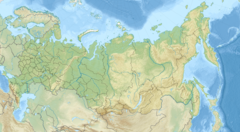| Revision as of 13:16, 16 June 2021 editG. Moore (talk | contribs)Extended confirmed users56,662 edits add russia map← Previous edit | Revision as of 11:57, 30 October 2021 edit undoModun (talk | contribs)Extended confirmed users1,713 editsNo edit summaryNext edit → | ||
| Line 23: | Line 23: | ||
| }} | }} | ||
| The '''Anabar''' ({{lang-rus|Анабар|r=Anabar}}, in its upper course: Большая Куонамка ''Bolshaya Kuonamka''; {{lang-sah|Анаабыр|translit= |
The '''Anabar''' ({{lang-rus|Анабар|r=Anabar}}, in its upper course: Большая Куонамка ''Bolshaya Kuonamka''; {{lang-sah|Анаабыр|translit=Anaabyr}}) is a ] in ], ], located between the rivers ] and ]. Its catchment extends into the ] that form the highest part of the ]. It is {{convert|939|km}} long, and has a drainage basin of {{convert|100000|km2}}.<ref name=gvr>{{GVR|233759|Река Анабар (Бол. Куонапка)}}</ref> | ||
| Its mean annual discharge is approximately {{convert|500|m3/s|cuft/s}}, concentrated heavily in early summer when the ice that covers the river for most of the year thaws. The ] is believed to be the easternmost ] in Russia – defining the point at which the climate during the ] became too dry for ] to form. A clear transition from fjords to deltas at river mouths is apparent shortly to the east at the ] ]. | Its mean annual discharge is approximately {{convert|500|m3/s|cuft/s}}, concentrated heavily in early summer when the ice that covers the river for most of the year thaws. The ] is believed to be the easternmost ] in Russia – defining the point at which the climate during the ] became too dry for ] to form. A clear transition from fjords to deltas at river mouths is apparent shortly to the east at the ] ]. | ||
Revision as of 11:57, 30 October 2021
River in Russia| Anabar | |
|---|---|
 Anabar river basin Anabar river basin | |
 | |
| Location | |
| Country | Russia |
| Physical characteristics | |
| Source | |
| • location | Anabar Plateau |
| Mouth | Laptev Sea |
| • coordinates | 73°12′19″N 113°33′24″E / 73.2052°N 113.5567°E / 73.2052; 113.5567 |
| Length | 939 km (583 mi) |
| Basin size | 100,000 km (39,000 sq mi) |
| Discharge | |
| • average | 498 m/s (17,600 cu ft/s) |
The Anabar (Russian: Анабар, romanized: Anabar, in its upper course: Большая Куонамка Bolshaya Kuonamka; Template:Lang-sah) is a river in Sakha, Russia, located between the rivers Khatanga and Olenyok. Its catchment extends into the Putoran Mountains that form the highest part of the Central Siberian Plateau. It is 939 kilometres (583 mi) long, and has a drainage basin of 100,000 square kilometres (39,000 sq mi).
Its mean annual discharge is approximately 500 cubic metres per second (18,000 cu ft/s), concentrated heavily in early summer when the ice that covers the river for most of the year thaws. The Gulf of Anabar is believed to be the easternmost fjord in Russia – defining the point at which the climate during the Last Glacial Maximum became too dry for glaciers to form. A clear transition from fjords to deltas at river mouths is apparent shortly to the east at the Lena River delta.
The basin of the Anabar river is notable as the location of the largest concentration of diamond deposits in the world outside of Africa and Australia. These deposits made the Soviet Union into one of the world's largest producers of diamonds, and remain the economic mainstay of the area.
History
Historically Evenks have inhabited the basin of the Anabar River. Vasiliy Sychev was the first Russian to reach the river in 1643.
References
- "Река Анабар (Бол. Куонапка) in the State Water Register of Russia". textual.ru (in Russian).
- Forsyth, James (1992). A History of the Peoples of Siberia: Russia's North Asian colony 1581-1990. Cambridge: Cambridge University Press.
- Armstrong, Terence (2010). Russian Settlement in the North. Cambridge University Press.
- Holland, Clive (1994). Arctic Exploration and Development, c. 500 B.C. to 1915: an encyclopedia. New York: Garland.